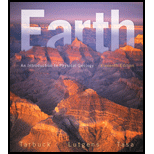
(a)
The average yearly rate at which the ice in the centre of the glacier advanced.
(a)
Answer to Problem 1GST
Explanation of Solution
Given info:
Number of years taken for the movement is
Explanation:
The expression for calculating the average yearly rate at which the glacier advanced in the centre,
Substitute
(b)
The speed at which the glacier advances per day in the centre.
(b)
Answer to Problem 1GST
Explanation of Solution
Given info:
We found from above that the annual rate of movement of the glacier in the centre is
Explanation:
The expression for calculating the speed at which the glacier advances in the centre per day,
Substitute
(c)
The average rate at which the ice along the sides of the glacier moved forward.
(c)
Answer to Problem 1GST
Explanation of Solution
Given info:
Number of years taken for the movement is
Explanation:
The expression for calculating the average rate at which the glacier advanced along the sides,
Substitute
(d)
The reason for the difference in the rate of movement of the glacial ice in the centre and along the sides.
(d)
Answer to Problem 1GST
The frictional drags causes the glacial ice to flow at a slower rate along the sides whereas the central part is devoid of friction and can move at a faster rate.
Explanation of Solution
During the movement of glacial ice, the movement occurs both internally and externally. The frictional drag affects the external motion of the ice and it is more along the sides and bottom of the glacier.
The central part of the glacier escapes from the friction. This causes the central part of the glacial ice to advance forward at a faster rate than those along the sides, thus bringing difference in the rate of movement in the centre and along the sides of the glacier.
Want to see more full solutions like this?
Chapter 18 Solutions
Earth: An Introduction to Physical Geology
- N (120') -1180- (120') (105') 0 50 100 feet 1160- -1140- A (100') B (90') (80) Proposed well -1120. (95) (80°) (80') 1100 Well location (Depth to top of water table) A Figure 8.14 Hypothetical topographic map showing the locations of several water wells. The numbers in parentheses indicate the depth of the water table below the surface in each well.arrow_forwardDue tomorrow 3/27 2 pm if you could give me detailed solutions pleasearrow_forwardDue 3/27 at 2pmarrow_forward
- Based on the Climate-Change Censorship campaign article (WSJ) does the phenomenon of scientific certainty ever exist? Why or why not?arrow_forwardBased on the Climate-Change Censorship campaign article (WSJ) some think that twitter, snapchat, instagram, facebook, google, messenger, et al. are the new forums for public discourse. Should the big tech company owners of these sites be allowed to censor the information and comments posted by the public?arrow_forwardHow does radon enter a home?arrow_forward
 Applications and Investigations in Earth Science ...Earth ScienceISBN:9780134746241Author:Edward J. Tarbuck, Frederick K. Lutgens, Dennis G. TasaPublisher:PEARSON
Applications and Investigations in Earth Science ...Earth ScienceISBN:9780134746241Author:Edward J. Tarbuck, Frederick K. Lutgens, Dennis G. TasaPublisher:PEARSON Exercises for Weather & Climate (9th Edition)Earth ScienceISBN:9780134041360Author:Greg CarbonePublisher:PEARSON
Exercises for Weather & Climate (9th Edition)Earth ScienceISBN:9780134041360Author:Greg CarbonePublisher:PEARSON Environmental ScienceEarth ScienceISBN:9781260153125Author:William P Cunningham Prof., Mary Ann Cunningham ProfessorPublisher:McGraw-Hill Education
Environmental ScienceEarth ScienceISBN:9781260153125Author:William P Cunningham Prof., Mary Ann Cunningham ProfessorPublisher:McGraw-Hill Education Earth Science (15th Edition)Earth ScienceISBN:9780134543536Author:Edward J. Tarbuck, Frederick K. Lutgens, Dennis G. TasaPublisher:PEARSON
Earth Science (15th Edition)Earth ScienceISBN:9780134543536Author:Edward J. Tarbuck, Frederick K. Lutgens, Dennis G. TasaPublisher:PEARSON Environmental Science (MindTap Course List)Earth ScienceISBN:9781337569613Author:G. Tyler Miller, Scott SpoolmanPublisher:Cengage Learning
Environmental Science (MindTap Course List)Earth ScienceISBN:9781337569613Author:G. Tyler Miller, Scott SpoolmanPublisher:Cengage Learning Physical GeologyEarth ScienceISBN:9781259916823Author:Plummer, Charles C., CARLSON, Diane H., Hammersley, LisaPublisher:Mcgraw-hill Education,
Physical GeologyEarth ScienceISBN:9781259916823Author:Plummer, Charles C., CARLSON, Diane H., Hammersley, LisaPublisher:Mcgraw-hill Education,





